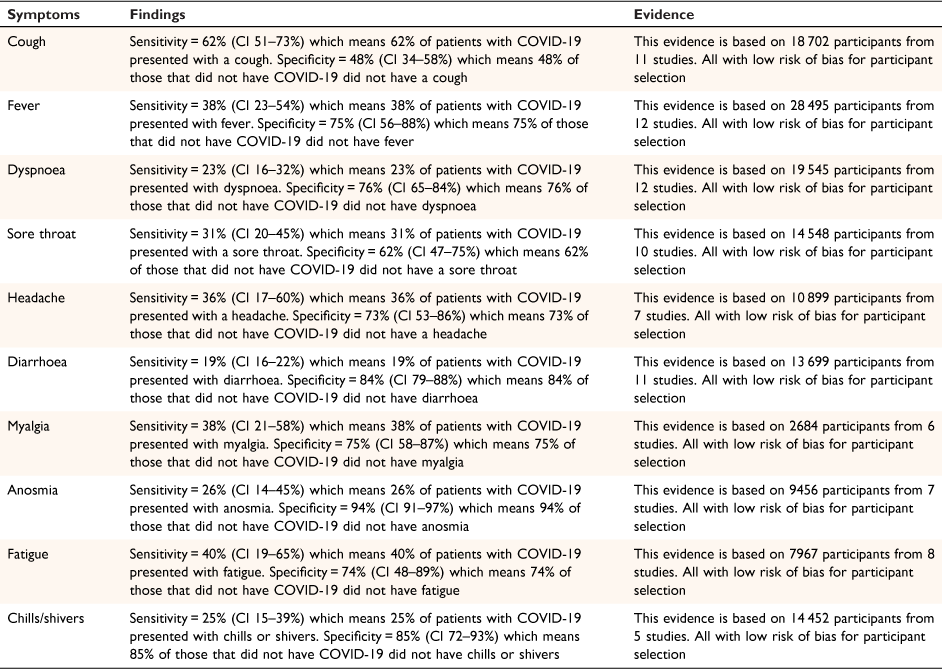Coronavirus (COVID-19): using signs and symptoms to diagnose COVID-19 in primary care
Vanessa Jordan 1 *
1 *
1 Department Obstetrics and Gynecology, Grafton Campus, University of Auckland, Auckland, New Zealand and New Zealand Cochrane Fellow.
Journal of Primary Health Care 14(2) 187-188 https://doi.org/10.1071/HC22065
Published: 16 June 2022
© 2022 The Author(s) (or their employer(s)). Published by CSIRO Publishing on behalf of The Royal New Zealand College of General Practitioners. This is an open access article distributed under the Creative Commons Attribution 4.0 International License (CC BY).
Cochrane Review: Struyf T, Deeks JJ, Dinnes J, Takwoingi Y, Davenport C, Leeflang MMG, Spijker R, Hooft L, Emperador D, Domen J, Tans A, Janssens S, Wickramasinghe D, Lannoy V, Horn SR A, Van den Bruel A. Signs and symptoms to determine if a patient presenting in primary care or hospital outpatient settings has COVID-19. Cochrane Database of Systematic Reviews 2022, Issue 5. Art. No.: CD013665. doi: 10.1002/14651858.CD013665.pub3.1
Background
On 11 March 2020 the World Health Organization (WHO) declared the novel coronavirus (COVID-19) outbreak a global pandemic.2 The increased workload caused by COVID-19 in an already overburdened health care system3 has caused clinicians to search for easy-to-use tools that could be used for diagnosis to avoid work overload.4 Symptom and sign evaluation has been suggested as a potentially useful tool. The objective of the Cochrane review summarised here, was to determine the diagnostic accuracy of symptoms and signs for COVID-19 in people presenting to primary care or hospital outpatient settings.1
Clinical bottom line
From the available evidence neither presence of absence of any one symptom could be relied on to predict the presence of COVID-19. Although some studies are now looking at combinations of symptoms and their ability to predict infection, there is currently not enough studies looking at the same combinations to provide any reliable evidence. Some symptoms may increase the likelihood of COVID-19, such as cough, but if further testing were not carried out on individuals without the presence of cough there would be large numbers of missed cases1 (Table 1).

|
References
[1] Struyf T, Deeks JJ, Dinnes J, et al. Signs and symptoms to determine if a patient presenting in primary care or hospital outpatient settings has COVID‐19. Cochrane Database Syst Rev 2022; 5 CD013665| Signs and symptoms to determine if a patient presenting in primary care or hospital outpatient settings has COVID‐19.Crossref | GoogleScholarGoogle Scholar |
[2] World Health Organization. WHO Director-General’s opening remarks at the media briefing on COVID-19 - 11 March 2020.
[3] Riddell A, MacLeod I, Davis P. Omicron to slam a health system at ‘breaking point’. newsroom, 2022. New Zealand.
[4] Whiteside T, Kane E, Aljohani B, et al. Redesigning emergency department operations amidst a viral pandemic. Am J Emerg Med 2020; 38 1448–1453.
| Redesigning emergency department operations amidst a viral pandemic.Crossref | GoogleScholarGoogle Scholar |


